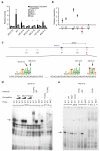Recessive mutations in a distal PTF1A enhancer cause isolated pancreatic agenesis
- PMID: 24212882
- PMCID: PMC4131753
- DOI: 10.1038/ng.2826
Recessive mutations in a distal PTF1A enhancer cause isolated pancreatic agenesis
Abstract
The contribution of cis-regulatory mutations to human disease remains poorly understood. Whole-genome sequencing can identify all noncoding variants, yet the discrimination of causal regulatory mutations represents a formidable challenge. We used epigenomic annotation in human embryonic stem cell (hESC)-derived pancreatic progenitor cells to guide the interpretation of whole-genome sequences from individuals with isolated pancreatic agenesis. This analysis uncovered six different recessive mutations in a previously uncharacterized ~400-bp sequence located 25 kb downstream of PTF1A (encoding pancreas-specific transcription factor 1a) in ten families with pancreatic agenesis. We show that this region acts as a developmental enhancer of PTF1A and that the mutations abolish enhancer activity. These mutations are the most common cause of isolated pancreatic agenesis. Integrating genome sequencing and epigenomic annotation in a disease-relevant cell type can thus uncover new noncoding elements underlying human development and disease.
Figures



Comment in
-
Enhancer mutations and phenotype modularity.Nat Genet. 2014 Jan;46(1):3-4. doi: 10.1038/ng.2861. Nat Genet. 2014. PMID: 24370740
References
-
- Sellick GS, et al. Mutations in PTF1A cause pancreatic and cerebellar agenesis. Nature genetics. 2004;36:1301–5. - PubMed
-
- Tutak E, et al. A Turkish newborn infant with cerebellar agenesis/neonatal diabetes mellitus and PTF1A mutation. Genetic counseling. 2009;20:147–52. - PubMed
-
- Al-Shammari M, Al-Husain M, Al-Kharfy T, Alkuraya FS. A novel PTF1A mutation in a patient with severe pancreatic and cerebellar involvement. Clinical genetics. 2011;80:196–8. - PubMed
Publication types
MeSH terms
Substances
Supplementary concepts
Grants and funding
LinkOut - more resources
Full Text Sources
Other Literature Sources
Medical
Molecular Biology Databases

